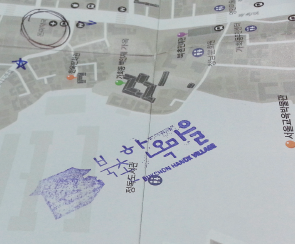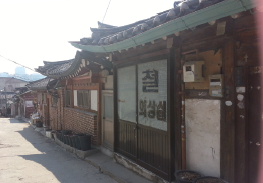
Just as Seoul is always developing, its urban lifestyle and housing environment are also changing dramatically. Now, people live in high-rise residential buildings and digitalized homes. So, it is not easy to see a Hanok village or a traditional Korean residential area. However, if you visit Anguk station, you will find a large cluster of privately owned Hanok houses. The Hanok village has two separate sections: Bukchon and Western Neighborhood of Gyeongbok palace.
1. Bukchon Wanderings
Bukchon’s name comes from its location; it is located to the north of Chenggye stream, a creek flowing west to east through downtown Seoul’s Jongno area, one of the oldest major thoroughfares in central Seoul. Flanked by two palaces, Gyeongbok palace to the west and Changdeok palace to the east, the village used to be an upscale residential area for wealthy aristocrats and court employees. Traces of old roads and waterways as well as stone and timber dwellings transform present day to centuries long past. Today, the areas of Gahoe-dong and Gye-dong in Bukchon have especially well-preserved Hanok homes that are still inhabited by residents today. Recently, a growing number of architects and painters have opened studios and offices there. Galleries, restaurants, quaint cafes, boutiques, and art shops creates a cozy ambient street atmosphere defining the neighborhood near Gyeoungbok palace, especially along Samcheong-dong-gil. Hanok Lodging: Traditional Korean Living Hanok lodgings in the heart of Seoul invite both domestic and international visitors to feel an exotic alternative to Western-style hotels and offer a wonderful chance to experience traditional Korean culture.

Hanok Lodging: Traditional Korean Living
Hanok lodgings in the heart of Seoul invite both domestic and international visitors to feel an exotic alternative to western-style hotels and offer a wonderful chance to experience traditional Korean culture.
Art Galleries: Sagan-dong Alley
Against a picturesque backdrop formed by the distant Gyeongbok palace, galleries galore attract art-lovers with diverse exhibitions in an alley that stretches from the entrance of Sam-cheongdong. Branches of the alley that head toward Sam-cheong-dong are also full of galleries.
Unpretentious Allure: Gahoe-dong Alley
31 Gahoe-dong is one of the most well preserved collections of Hanok homes in Bukchon. The Hanok clusters along the alley are interspersed with craftwork studios and museums. An uninterrupted and refreshing view of downtown Seoul stretches between the Hanok house rooftops.
Travel Back Through Time: Gye-dong Alley
Gye-dong-gil, a road stretching from Hyundai Heartquarters, features old public bathhouses, barber shops, and stationary stores that evoke a sense of nostalgia for the good old days. Craftwork studios and old stores form small clusters. Hanok houses are found concentrated inside the small alleys along Gye-dong-gil.
2. Walking through the Western Neighborhood of Gyeongbok palace
Historically, the Western Neighborhood of Gyeongbok palace was place court ladies, official doctors, and the petite bourgeoisie of the Joseon Dynasty resided. The birthplace of King Sejong, the Great, and the homes of General Gwon Yul and Lee Hangbok show the residential culture of diverse social classes during the Joseon Dynasty. Influential families also built vacation homes along the foot of Inwang mountain to enjoy the mountain’s picturesque scenery. The Western Neighborhood of Gyeongbok palace is also the birthplace of the poetry club, which holds an essay contest established by Jeong Seon. The Western Neighborhood of Gyeongbok palace is a famous Korean retro neighborhood with approximately 660 Hanok houses, old alleys, and traditional markets. Here are four themed walking routes that the Sookmyung Times recommend.



Route One: Art Walk
This route leads travelers through the alley next to the stone wall of Gyeongbok palace. It is lined with roughly 30 art galleries and studios. Also, the area is renowned for its cafés and diverse cultural spaces housed in Hanok homes and modern renovated old buildings. For example, Gallery Artga is housed in a renovated 80-year-old Japanese style building. T he gallery attempts to introduce visitors to diverse collections from fine arts to architecture to pottery to multimedia, etc. It also features the work of up and coming younger artists.
Route Two: Nostalgia
The Nostalgia route well conserves the feeling of Seoul streets in the 1960s and 1970s. The route is lined with old bookstores, hardware shops, and grocery stores hidden amongst a traditional market that may conjure up memories of youthful days. For example, Tongin Market is a traditional market that gained recognition as a public market in 1941; currently it hosts about ninety or so small stores that greet shoppers daily. A permanent exhibition hall within the market displays photos of the market taken during the Japanese colonial rule of Korea to Korea’s present day.
Route Three: Alleys
This route tours the Chebu-dong area, a neighborhood boasting the oldest network of alleyways in Seoul. The Alleys route provides visitors a glimpse into simple life and culture as well as the friendly atmosphere of the Western Neighborhood of Gyeongbok palace. For example, Pirundae is the name of the home of Lee Hangbok, a renowned Joseon Dynasty statesperson. Hangbok is famous for his friendship with fellow respected politician Lee Deokgyeong. The story, which has been passed down the generations, is titled Oseong and Han-eum. Oseong and Han-eum are the childhood names of them respectively.
Route Four: Sky View
The Sky View runs from Inwang Mountain, gorgeously depicted in Jeong Seon’s portrait, to Suseong-dong Valley. The area Han-gyeng-ji-ryak is the most scenic in Seoul. For example, Ogin Store runs a social community gathering for people who cherish the Western Neighborhood of Gyeongbok palace. Currently, Ogin store is hosting a photo exhibition.


Information
PLACE Hanok Village
HOW TO GO Ten minutes from the Exit 1 or 2,
Line 3 Anguk station
TIME Always
PRICE Free
HOMPAGE http://bukchon.seoul.go.kr


